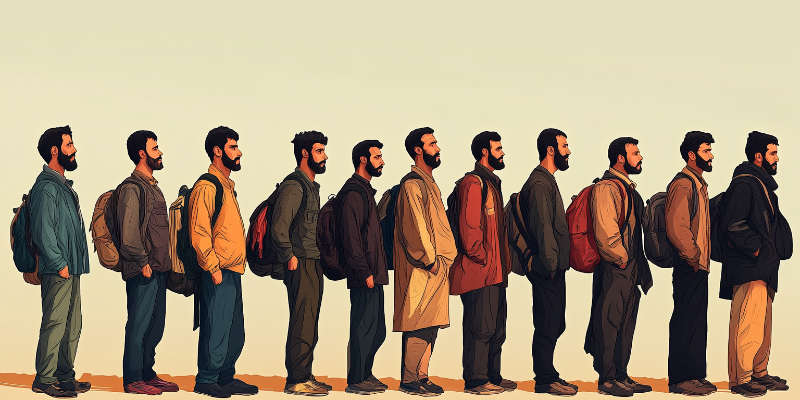The Refugee Crisis: Facts and Misconceptions

Migration and asylum have become highly contentious issues across the globe. While the asylum system was originally designed to protect people facing genuine persecution or threats, reports and studies indicate a worrying trend: a significant number of so-called “refugees” misuse the system. This phenomenon has wide-ranging consequences for societies, both economically and socially, and raises questions about the effectiveness of current policies.
Who Qualifies as a Genuine Refugee?
According to international treaties, such as the 1951 Refugee Convention, a refugee is someone who flees their country due to race, religion, nationality, political opinion, or membership of a particular social group because of a well-founded fear of persecution. This is a strict definition, and not everyone leaving their country for economic or social reasons qualifies.
In practice, however, the distinction between genuine refugees and economic migrants is often blurred. Many asylum seekers come from relatively stable countries where no systemic persecution or war occurs, such as Turkey, Morocco, Albania, or parts of South America (Global Migration Trends, Rexje). This means a significant portion of asylum seekers are economic migrants seeking access to welfare benefits and better living conditions, rather than fleeing real danger.
Global Trends in Asylum Applications
Across Europe, North America, and parts of Asia, asylum approval rates indicate that the system is often misused:
- In many countries, around 70–80% of asylum applications are accepted, despite doubts about the legitimacy of claims (Asylum Practices Worldwide, Jansen).
- Research shows that many approvals come from applicants who previously resided in safe countries or whose situations do not meet the criteria of genuine refugee status. For example, many applicants from North Africa and parts of Eastern Europe provide limited evidence of persecution (Refugees and Migration, De Vries).
- Thousands of asylum seekers annually arrive from countries with no active conflicts, motivated primarily by economic opportunities, education, and social benefits (Economic Migration and Asylum, Bakker).
These trends show that asylum systems globally are vulnerable to misuse, blurring the line between protection and economic migration.
Causes of System Abuse
Abuse of the asylum system stems from several factors, both individual and systemic. Understanding these is crucial to shaping more effective policies.
1. Economic Motivations
A significant portion of those claiming asylum are motivated by better economic conditions. Countries with robust welfare states, such as those in Europe and North America, attract migrants seeking social benefits, housing, healthcare, and education. For individuals from regions with high unemployment or low wages, this is a strong incentive to seek asylum, even without legitimate persecution (Economic Migration and Asylum, Bakker).
Young, healthy, and mobile men are often overrepresented among these applicants, using legal or illegal routes to establish a stable life in wealthier countries. The difference between genuine refugees and economic migrants often only becomes apparent after approval, by which point the system has already granted access to benefits.
2. Inadequate Verification and Procedures
Asylum authorities worldwide face overwhelming workloads, leading to expedited processing and insufficient verification of claims. Audits in several European countries revealed that around 80% of asylum dossiers contained incomplete or questionable information without resulting consequences (Audit of Asylum Systems, Dutch Court of Audit).
The lack of robust cooperation with home countries or international verification mechanisms exacerbates the problem. Often, authorities rely on personal statements from applicants, making the system vulnerable to exaggeration or fabricated claims.
3. International Routes and Networks
Asylum seekers exploit international migration networks to access countries with more favorable policies. For instance, individuals often travel first to countries with more lenient admission criteria before moving to countries with stricter systems, including the United States, Germany, or Canada (Global Migration Routes, Van den Berg).
Organized smuggling networks frequently advise migrants on the best strategies to gain asylum, further amplifying system misuse and challenging border control agencies.
Social and Economic Consequences
System abuse has far-reaching consequences for societies around the world, affecting both local communities and national policies.
Pressure on Social Services
High numbers of asylum applications place significant pressure on housing, healthcare, and education systems. Temporary shelters, emergency facilities, and additional staff are often required, sometimes leading to local shortages for citizens (Local Impact of Asylum Reception, De Boer).
Cities in countries such as Germany, Sweden, and Canada have resorted to using gyms, community centers, and even military facilities as temporary shelters, creating logistical challenges and friction with local residents.
Public Frustration and Political Polarization
When citizens see asylum seekers with questionable claims receiving extensive benefits, trust in government and public institutions declines. This can fuel political polarization, the rise of anti-immigration movements, and tensions within communities (Migration and Society, Smits).
The perception of unfairness is particularly acute in societies where citizens struggle economically and witness newcomers receiving extensive support while integration remains slow.
Economic Costs
In addition to direct costs for reception and integration, there are indirect effects on labor markets and public finance. Economic migrants in asylum systems may take low-wage jobs, potentially displacing local workers, while prolonged dependence on social services strains public budgets (Asylum and Economy, Van Dijk).
Governments also bear additional expenses for interpreters, legal aid, and social support programs, increasing costs while benefits for society remain limited if integration is delayed or unsuccessful.
Strategies to Identify and Reduce Abuse
Although many refugees genuinely need protection, evidence shows that system abuse is widespread. Measures to mitigate this include:
- Stricter verification of claims: International databases, cooperation with home countries, and intelligence sharing can help detect false claims more effectively (Audit of Asylum Systems, Dutch Court of Audit).
- Enhanced procedural checks: In-depth interviews, thorough background investigations, and digital verification can reduce vulnerability to fraud (Asylum Practices Worldwide, Jansen).
- Clear distinction between refugees and economic migrants: Policies explicitly differentiating protection needs allow genuine victims faster access while limiting abuse (Refugees and Migration, De Vries).
- Transparent communication: Public information campaigns about the scale and nature of asylum abuse can reduce frustration and prevent polarization (Migration and Society, Smits).
Governments must not only prevent misuse but also enforce sanctions and return policies consistently to deter false claims.
Long-Term Implications
Continued economic migration through asylum systems can have serious long-term consequences globally:
- Declining trust in authorities: When rules are perceived as easily circumvented, public confidence in institutions erodes (Local Impact of Asylum Reception, De Boer).
- Integration challenges: Migrants arriving for economic reasons may have less motivation or capacity to integrate, leading to social segregation and long-term costs (Asylum and Economy, Van Dijk).
- Labor market distortions: Large numbers of economic migrants may depress wages and compete with low-skilled native workers (Economic Migration and Asylum, Bakker).
These outcomes highlight the importance of maintaining clear distinctions between genuine refugees and economic migrants in international asylum policies.
Conclusion
Globally, countries face the challenge of protecting people who are genuinely persecuted while limiting abuse of asylum systems. Current practices demonstrate that a significant portion of claims stem from economic or social motivations rather than actual need. This creates pressure on public services, increases costs, and fosters societal tensions.
Effective verification mechanisms, clear eligibility criteria, and transparent communication are essential to maintain balance between humanitarian obligations and realistic policymaking. Focusing on facts and data ensures that asylum systems remain just, sustainable, and capable of serving those truly in need.


















